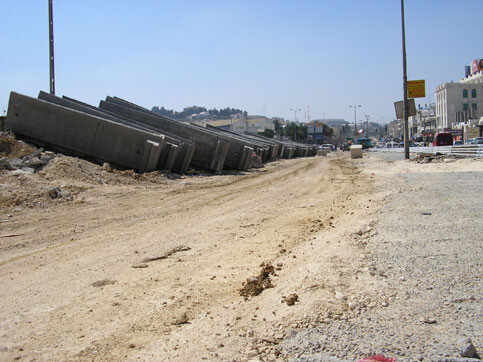B'Tselem 22 June 2005

2004, concrete parts of Israel’s Apartheid Wall in ar-Ram between Kalandia and Beit Hanina (Arjan El Fassed)
On the 22nd of June 2005, Israel’s High Court of Justice issued a temporary injunction ordering the government to cease construction of the wall south of a-Ram village, northeast of Jerusalem, until arguments for a petition against the wall are heard. Initially, Israel decided to erect this section of the wall along the Jerusalem municipal boundary, as it was fixed following the annexation of the city’s eastern part in 1967. However, in response to the petition of several institutions situated in Dahiyat al-Barid (southern a-Ram), Israel elected to shift the route of the barrier northward, which would isolate part of the neighborhood from the rest of the village. The current injunction was issued at the request of the head of the a-Ram village council and a group of Dahiyat al-Barid residents, who petitioned that the neighborhood not be divided from the rest of the village.
A-Ram lies northeast of Jerusalem, just outside the city’s municipal border. The village is part of the built-up urban area of Jerusalem: the Atarot industrial zone and the Palestinian neighborhood of Beit Hanina lie to the west, and the Neve Ya’akov settlement borders it on the south. To the north is the Qalandiya refugee camp, most of which lies outside the Jerusalem municipal boundary.
The separation barrier under construction will surround a-Ram on three sides. West of the village, Israel has completed a wall eight meters high, along the main road to Ramallah. To the south, a wall is planned a distance of several hundred meters from the municipal boundary, separating part of the neighborhood Dahiyat al-Barid, in the south of a-Ram, from the rest of the village. The wall will stretch between the residents’ houses and the northwest edge of Neve Ya’akov. From there, the barrier will run north and surround a-Ram almost completely from the east, separating the community from the empty space between it and Neve Ya’akov. This section is presently being built. No barrier is planned north of a-Ram, on the cliff on which the community is located, and which overlooks Route 45, the road that links the settlements in this area with Jerusalem (via the Begin Highway) and the coastal plain (via Route 443).
The head of the a-Ram village council estimates that 58,000 people live in the village. More than half of them hold Israeli identity cards. The residents have extensive economic, educational, health and family relations with East Jerusalem residents and institutions. Since the barrier’s construction began, several thousand residents with Israeli identity cards have moved to East Jerusalem.
The barrier will severely hamper access to schools. Twenty thousand students, 4,000 of them from East Jerusalem, currently study in schools in a-Ram. Some of the teachers come from East Jerusalem, and others from nearby Palestinian villages. Five thousand students living in a-Ram and holding Israel identity cards study in schools in East Jerusalem, primarily in Beit Hanina and Shu’afat. The barrier will also obstruct higher education. A-Ram has one college, with 700 students from the community and surrounding areas. Most of the college students who live in a-Ram study outside the village, and will have difficulty reaching their schools once the barrier is built.
Access of residents of a-Ram to hospitals and medical clinics will also be affected. Medical services are almost non-existent in a-Ram, and most of the residents use the hospitals and clinics in East Jerusalem. Several thousand residents of a-Ram suffer from chronic illnesses (such as diabetes, high blood pressure, heart disorders, cancer, kidney disorders) and require treatment a few times a week. Ninety-five percent of women from a-Ram give birth in Jerusalem hospitals (some in hospitals in West Jerusalem). Eight thousand children from a-Ram receive their immunization shots in Jerusalem. Also, some of the 1,500 disabled children living in a-Ram are treated in the Disability Fitness Center in Qalandia, which is located northwest of a-Ram.
The barrier will also affect the livelihood of residents of a-Ram. Most of the labor force in the village works in Jerusalem and at other locations in Israel. Palestinians without an Israel identity card or permit are not allowed to enter Jerusalem, and Israelis are not allowed to enter Area A of the West Bank. Because A-Ram is strategically located just outside Jerusalem and in the middle of the north-south axis of the West Bank, the village has become a lively commercial center. With the construction of the barrier, many shops and factories have closed, and others are expected to close because of the access and movement problems facing workers, customers, and transporters of goods and merchandise.
The harm suffered by residents of a-Ram has not resulted solely from its detachment from Jerusalem. It also results from its separation from five villages situated just to its west – Bir Nabala, al-Judeira, al-Jib, Beit Hanina al-Balad, and Nebi Samuel. These villages will be surrounded by the barrier and become a separate enclave. Residents of a-Ram have close social and family ties with residents of these villages. Bir Nebala, for example, lies only half a kilometer from a-Ram. A person can now go from one village to the other by crossing the Ramallah Road and passing through an opening in the wall. When the opening in the wall is closed, as called for in the plans, the residents will have to travel more than twenty kilometers via Ramallah to make the same journey.
Related Links